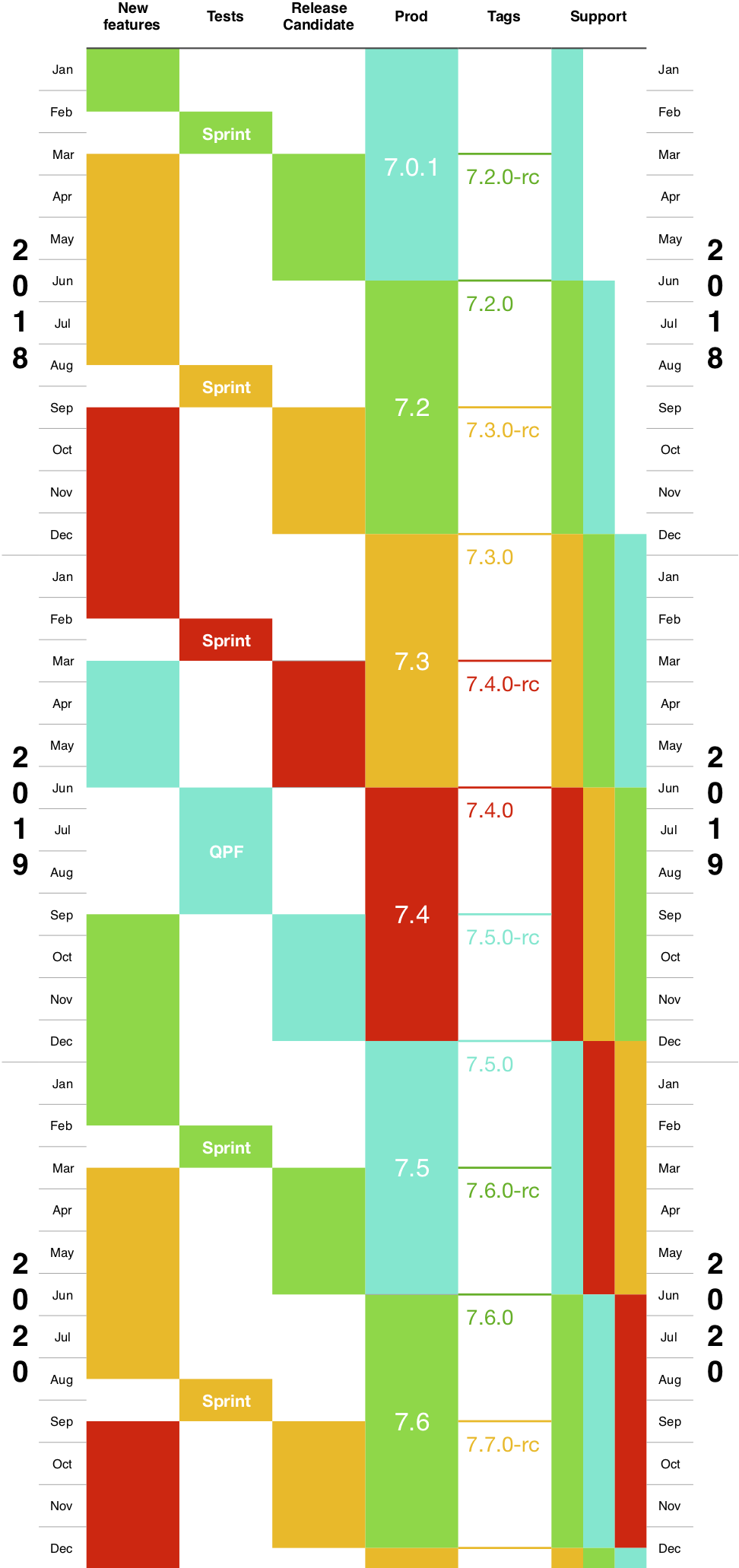Reading time 5 min
Road in Scotland, Photo Sven Vee. The versioning strategy depicted here is a permissive “You can scout anywhere, as long as you keep the main road in sight”, with a straight road.
Versioning of large research softwares for industry can be sloppy because the audience is torn apart: end-users need a clear official version, while research asks for myriads of exploratory versions.
AVBP, born in the 1990s, is a combustion software used and developed today by dozens of industrials and researchers simultaneously. This post will explain of this still can fit into the semantic versioning strategy.
The audience of a research software
Researchers
Researchers write software for their publications. Once the results are there, the focus goes into the very demanding process of writing a paper (and finding funds, and supervising, and… ok). Versioning helps here to make sure the results can be reproduced. Utopia is: One paper - one version
Industrial, production side
Industrials use software for design. A good simulation result is reproducible, independent of the software, and should not open new questions unrelated to the design (“e.g. look, I changed the tolerance, and it goes the other way!” ). Trust is the main concern here, even before precision and performances. The trust in such complex tools takes years to build, and only weeks to crumble.
Utopia is: One Version, period
Industrial, exploration side
Before the software is accepted for design, it undergoes a long validation process. Both industrial and academical tests are run until both Researchers and Industrials give their approval.
Utopia is: One clean Version per year, with a 3 year visibility on future versions
Industrial, demonstration side
Sometimes, the case is really ambitious, and both sides agree to work on a demonstrator. This simulation will give insights on a specific application-driven issue, but will not be approved for production yet.
Utopia is : One demonstration - as many versions as we need.
The main road: a Bi-annual release
We start with the main official versions. The MAJOR version of AVBP today is 7.X., so all will start with a 7.
Exploration vs stabilization
There are Two MINOR versions per year.
- The exploration version is released in March. This agenda allows the use of internships to test new features and make feedbacks. 7.2, 7.4, 7.8 were exploration versions.
- The stabilization version is released in September. It allows a fresh start with a clean code base for new PhDs students. 7.3, 7.5 were stabilization versions
Each version undergoes the following steps:
- Features are implemented through internal development
- Development is paused as tests are performed. These tests are:
- a one month test sprint for most versions
- once every 2 years (4 versions) a “QPF campaign” occurs
- a release candidate version is tagged and distributed to all AVBP customers. A 3 month period is given for all feedback.
- the version is finally considered stable. A branch is created.
Note that “QPFs”, a.k.a Quality Program Forms are series of analytical test cases that the code is compared against. AVBP users can access these online.
You can see the development timeline, which is given below for the 3 year period 2018 - 2020.

For the record: due to the COVID-19 disruption, 7.8 became a stabilization version.
Features & Bugfixes
The version number is derived from the semantic versioning. In short, the features are frozen for each minor version. There is usually more new features on the explorations version. This mean a new feature is never back-ported in a previous version.
However the bugfixes are added on minor versions, and can be identified by the third number. A minor version can have a personal evolution on its branch, with a rising quality (e.g. the 7.3 family : 7.3.0, 7.3.2, 7.3.3, 7.3.4 ).
Now, You learnt that these three digits ; 7.X,X mark out the main road of AVBP versions. You can read more about this in semantic versioning for non-regression.
Industrial validation
Industrial will not switch automatically to each latest stabilization version. Indeed, even if the industrial non-regression is fully automated, each upgrade raises new questions on the production and can potentially erode the trust.
The version upgrade is therefore decided by the Industrial and both sides prepare in advance this period, which mobilize substantial manpower on both sides if a unexpected problem arise.
From Rogue versions to Scout versions
When a demonstration is scheduled, it often requires a specific version of the software, (e.g. a new model under development by a Phd student.
Forcibly merging this version in the official bi-annual schedule is not always a good idea. The AVBP versioning allows a fast-track.
The Industrial can use this “Scout version”, provided three requirements:
-
The Version is on a development branch of the AVBP Git versioning system. The name is usually looking like
FEATURE/awesome_model. -
Before any exchange of the branch, a new tag is added to help people in their discussion. Indeed, without a tag, a commit name is not human-readable: 0949c54a62f243488a63e695e4129315fada16f8. Make sure this tag is up to date and visible in your log file.
-
The version is compared to the current official version with the closest Industrial validation case during the demonstration campaign.
The second item can be time-consuming. This is why having an automated non-regression process on Industrial cases is critical.
Versioning the scout Versions
The tag format of an exploration version should follow semver with a unique word inside: 7.9.0-newmodel.1.
This is technically speaking a pre-release. The first part is the destination : this feature will be in the future 7.9.0.
The alternative could be have been using the origin: this feature is built on the version 7.9.0. There are however good reasons to focus on the destination:
- During a feature development, the developer must regularly merge the current best state of the code into its Feature Branch. So the origin changes, and the tag series does not make sense anymore:
7.9.0-newmodel.1,7.9.0-newmodel.2,7.10.0-newmodel.3. - The main dev team is not omniscient. If the tag does not start with
7.9.0, they might forget you were targeting this version, and could engage intrusive developments without warning you, increasing your workload - It does not comply to semver: the
-char says it is a pre-release. All7.9.0-loremipsu*are assumed prior to7.9.0. So you will create confusion for people who use semver on a daily basis, like the computer support of HPC centers. - As the minor releases are scheduled every six months, the tag name is a clue to the expected duration of the development.
Takeaway
The AVBP versioning uses:
- a road, an official trunk of main versions with scheduled releases every 6 months. Names are
7.3.2. - scouts, rogues versions used for explorations and demonstrations, provided they match the current main version on the closest industrial reference case. These are semver pre-releases of a future version
7.3.2-awesomeidea.5.
Both are equally needed and complementary for an active research code.
Going off-road in Buena Vista (Photo Holly Mandarich)
This work has been supported by the EXCELLERAT project which has received funding from the European Union’s Horizon 2020 research and innovation program under grant agreement No 823691.

